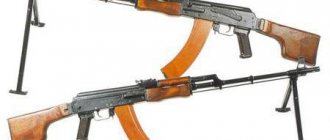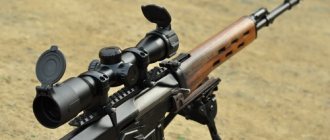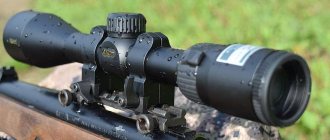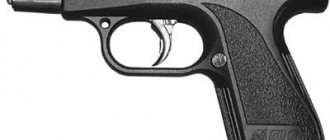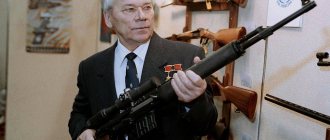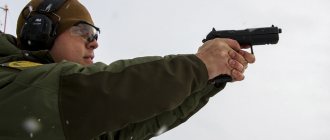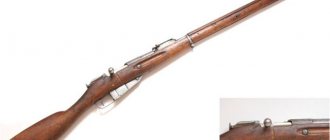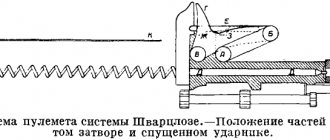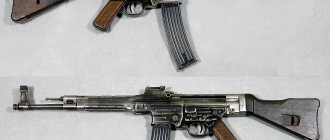Sights PSO, PO and POSP: unity in diversity
With all the richness of choice of modern optical sights, the constant interest of hunters and shooters is a device with a 50-year history and military career. This is a PSO - an optical sniper sight, according to some sources, originally “Ovchinnikov sniper sight” (after the name of the designer of the Novosibirsk Instrument-Making Plant).
One of the reasons for such popularity is related to the charisma of the product: a person who has chosen a conversion version of Soviet-Russian small arms - “Tiger”, as well as “Vepr” and “Saiga” - and an optical sight will try to choose the most authentic one. But the main driving force, of course, will be economic and practical considerations.
According to the Technical Specifications issued more than half a century ago, the PSO was required to have a guaranteed resource of 3 thousand rounds and another 6 thousand according to hardware reliability tests. 9,000 rounds for the owner of a sniper rifle, whatever you call it, means virtually a lifetime warranty. Even if he is not a hunter, but practices in near-sports disciplines. Still, this is not clay pigeon shooting.
In addition, after removal and installation, the PSO does not require zeroing (which was also stipulated in the technical specifications and implemented in practice). Considering the modern cost of ammunition, especially “targeted” or imported, this, you see, is an important factor.
As well as a very modest price by any standards. Since original PSOs are not available for free sale and can only be found on commission, the payment for devices decommissioned from the army is sometimes lower than the lower level, down to the traditional Russian “natural” price.
This applies mainly to the PSO-1 (4x24) version intended for SVD and its civilian version "Tiger" chambered for 7.62x54. In addition to it, the Novosibirsk Instrument-Making Plant produces PSO-1-1, PSO-1M2, PSO-2, PSO-3, intended for special weapons - VSK, VSS and others. First of all, the changes concern the mount, the sighting reticle and all adjustment and adjustment mechanisms that correspond to the ballistics of standard ammunition. In the photo - VSS "Vintorez" with a PSO-1-1 sight.
However, the only “minus” of the design, which was inherent from birth, is due to its purely military purpose – the lack of dioptric adjustment to the characteristics of vision. Indeed, it is difficult to imagine an army sniper suffering from astigmatism. But for many hunters, especially older ones, this can become a problem.
In addition, real PSOs of any series have already worked a lot in their lifetime before appearing on the civilian market. The body, mechanisms, and optics suffered. Compare the “pictures” of PSO-1 and modern civilian software 4x24.
The yellowness of the army sample is caused not only by age, but also by the use of the so-called “weaving” - glass with special additives that ensure radiation-optical stability (GOST 3514-94/76 and previous ones). But this is a completely separate topic.
In any case, if you decide to go with a completely authentic military sight, look for a “fresher” option. Otherwise, you may encounter such a seemingly trifle as searching for an ancient original battery. Compare:
But the luminescent screen installed on early versions of the sight, rechargeable from any light sources, served not only to detect sources of infrared radiation, as many believe, but also actually acted as a prototype of night vision devices, providing night recognition of targets at a distance of up to 100-150 meters. It was removed from the design just with the advent of domestic night sights. However, the time of such devices is irrevocably gone...
Therefore, if you are purchasing a sight solely for practical purposes without any trace of collecting, pay attention to the civilian versions produced by oil refineries under the general software index. In terms of strength, reliability and durability, they are practically no different from the military prototype. Yes, their tests are carried out according to a more gentle program, for example, not at -50, but at -40 degrees, but the parts, assembly lines, and workers are the same. In addition, the most extreme hunting, you see, is also different from combat.
A significant advantage of civilian sights is their wide range. There is a complete analogue of PSO-1 - PO 4x24. Like the prototype, it is designed for SVD/Tiger rifles.
The 4x24-1 software for the Saiga and Vepr carbines is designed taking into account the mounting characteristics and ballistics of ammunition.
Sights with increased magnification and lens aperture PO 6x36, 6x36-1 and 6x36-2 are installed on both the Tiger and conversion Kalashnikov carbines, as well as SKS.
Finally, the Novosibirsk team brought to the market a line of pancratic sights. In the photo is the “younger” model - 1.5-4.5x16 “Tiger”.
PO 3-9x24, intended for the "Tiger" and "Vepr", and PO 3-9x24-1 - also for the "Saiga".
All of them, like modern modifications of their military counterparts, are absolutely sealed and filled with dried nitrogen, which guarantees moisture protection and no fogging at any temperature changes. There is also no doubt about reliability and durability.
Here is an excerpt from a letter from a specialist from the Federal State Unitary Enterprise for the Oil Refinery regarding the inspection of the plant’s products:
“Many enterprises are not interested in our existing and developing sighting equipment. This is a fact and we cannot escape this.
That’s why we supply high-quality equipment that has passed all types of tests, 100% of the products.
Tests are carried out in two stages (I’m talking about civilian products now): 1. By the manufacturing workshop, bearer tests (somewhat more gentle than QCD acceptance); 2. Quality control department, acceptance and delivery. Only devices that have passed the presentation tests are used for acceptance tests.
Important characteristics tested during testing include:
Resistance to mechanical shocks. Tests are carried out on an electromechanical three-component shock installation SM-1M. Number of blows - 100 (during standard tests - 500). The following accelerations are provided:
- in the horizontal direction (parallel to the optical axis) 328g
- in vertical direction 245g
- laterally 200g
And also, MANDATORY, all 100% of products (note, not selectively from a batch, not 10%, but ALL products) are tested for the effects of: critical temperatures, shaking, precipitation, dust and sand, tightness.”
At the same time, civilian sights of the PO series have retained a utilitarian military approach to aiming technology, which is fully compliant with field conditions and does not require special skills in working with modern mil-dot reticles, ballistic calculations, etc. Of course, any military sniper, even a beginner, is not an infantry “young untrained fighter,” but still...
Without deviating from the topic of the review, briefly about the methodology, which is the same for military and civilian devices. Their reticles themselves differ only in the “conversion” reduction in the basis of the height rangefinder scale from 1.7 meters for PSO (average human height) to one and a half meters for PO (pictured).
This is what the grid looks like with the backlight turned on. In reality, of course, the sharpness is much better than in the photo.
But let’s take the well-deserved army version as a basis.
Of the really necessary explanations, it should perhaps be said that the division price of the lateral correction scale corresponds to one thousandth (0-01). The rangefinder scale starts at 200 meters (direct shot distance) and ends at 1000 meters in 100 m increments.
When shooting up to 1000 meters, using a rangefinder scale (or another method), we determine the distance to the target and enter the distance using the vertical correction drum. Its main scale is digitized in hundreds of meters, the additional one (on top) allows you to enter clarifying adjustments when aligning the sight (division value is 0.5 thousandths).
On the drum (handwheel) of lateral corrections, the scale is graduated from zero to the right and left with a division value of 1 thousandth to 10. In full accordance with the horizontal scale of the grid.
At the ends of the handwheels there is a very “school” cheat sheet: on the side - “left STP”, “right STP”, on the top - “up STP” and “down STP”.
That is, adjusting the midpoint of impact does not cause any difficulties when shooting.
As, indeed, the shooting itself from the SVD/Tiger up to three hundred meters. Both the PSO-1 and the PO series, all mechanics, including brackets, are extremely reliable and not subject to slips and displacements. The technical accuracy of the rifle and the performance characteristics of the scope make it possible to maintain accuracy within the stated 1MOA at short and medium distances.
As distances increase and when shooting at extreme levels, the influence of external factors increases, including the quality of ammunition and the skills of the shooter himself. The need for calculations arises; a ballistic table prepared in advance will not hurt.
When it comes to rangefinders with a built-in ballistic calculator and weather stations, that is, high-precision long-range shooting and mountain hunting, economic considerations begin to fade into the background. A logical continuation is the idea of changing the rifle itself to something more suitable, at least in terms of weight and dimensions.
The scope faces the same fate, since the PSO/PO is not designed to be mounted on Weaver rails or the upper dovetail. And the field advantages of metric linear units of measurement disappear when using a calculator.
In this case, the shooter has a worthy alternative - products from the Belarusian Zenit under the symbol POSP.
They are based on the same legendary PSO-1, the production of which was transferred from the refinery to the related facilities of BelOMO in the mid-80s of the last century. After well-known events, the enterprise became an independent player and, following the logic of market relations, began modernizing its products.
At first, civilian models were practically no different from the prototype. In a slightly updated version, they are still on the assembly line. In the photo there is a POSP 4x24T (T for “Tiger”).
Explanation of the signs after the names of the sights:
- B – designed for installation on carbines of the “Vepr” and “Saiga” types;
- T – designed for installation on “Tiger” type carbines;
- W - designed for installation on weapons with top-mounted guide rails such as “Weaver”, “Picatiny rail”;
- L - designed for installation on carbines “Korshun”, “Sobol”, PZh-18NM;
- L7 - designed for installation on Los-7 carbines and modifications;
- L9 - designed for installation on Los-9 carbines and modifications;
- D (D) – depending on individual vision characteristics, it is possible to adjust the eyepiece from minus 3 to plus 3 diopters;
- M – modernized rangefinder reticle;
- C – the sight provides the ability to select the brightness of the reticle illumination depending on the illumination of the area;
- Pro - the sight has the ability to more accurately aim at the target;
- Numbers 1, 2... are grid numbers.
For clarity, we provide a table of the main grids. It should be noted that a simplified version - No. 10 - is often used in sights designed for Saiga carbines. It fully allows you to solve all the problems characteristic of this weapon.
Then the much-in-demand dioptric adjustment appeared on sights (products with the letters “D/D”) and, finally, devices with increased magnification entered the market, followed by lens apertures – 6x42 and 8x42. Below is a POSP 6x42VD.
That is, it has dioptric adjustment and is intended for Vepr and Saiga carbines.
The plant gradually expanded its product range. Currently on stream there are sights for the Korshun, Sobol, Los-7 and Los-9 carbines. The photo shows the POSP 8x42 L9.
Wide-angle sights PO 4x24P2 are designed for installation on any rifles and carbines equipped with a dovetail side mount, as well as on automatic small arms. When using brackets with adapters, installation is possible on models from foreign manufacturers - Heckler & Koch Gewehr 36, M-16, FN and others.
And most importantly, devices with a mount for the universal Weaver/Picatinny rail, as well as a Mildot reticle, have finally appeared. They are designated by the letters “W” and “M”.
The photo shows a POSP 8x42 WD M6 PRO.
The vertical corrections for such sights are entered not in conventional hundreds of meters, but in modern “clicks” (2.5 cm per 100 m). Now the problem of compatibility with imported ballistic calculators has disappeared by itself.
Thus, the factory program now contains all the main types of sighting reticles, from the classic SVD (and its other variant with a rangefinder “parabola” shifted down) to the “Mildot”, which has already become familiar with imported sights.
The next step of Zenit was the release of pankratic sights with variable magnification. From POSP 2.5-5×24 and POSP 2-6x24 (pictured)…
...to the flagship of the POSP 4-12x42 W M6 Pro line.
The production line also includes not very numerous models with a laser designator. Such as POSP 8x42 V with LCC-OM.
They are intended for Vepr and Saiga carbines and greatly facilitate aiming at short and medium distances.
As you can see, the range of civilian products among Belarusians is much wider than that of oil refineries. Quality and reliability are also okay. Created as part of the leading republican production association in 1973, the plant managed to gain momentum and accumulate significant experience even before the collapse of the Union. And then he even managed to get a head start over his Russian colleagues. Do not forget that the domestic military-industrial complex began to revive literally in recent years, while in the fraternal republic the problems of military development and the defense industry have always been given increased attention.
Now the opportunity to get a head start appears at the Novosibirsk Instrument-Making Plant. The entire might of the Soviet defense industry was behind the development of the PSO series sights. Designers, technologists and mathematicians from renowned design bureaus, SKTB and research institutes took part in it. The absolute majority of them remained on Russian territory. Many, along with refineries, recently became part of the largest holding JSC Shvabe and are now reviving the Russian weapons school at an accelerated pace.
Introduction of amendments
In terms of range, you need to set the upper handwheel to the required division, which corresponds to this distance. Horizontally, the sidewall needs to be untwisted to the red numbers. If the reticle goes to the left, the bullets will go in the opposite direction. If you focus on black numbers, then vice versa.
Lateral corrections for moving targets and for the wind are made by rotating horizontal flywheels. The scale has divisions with a plus sign for the right adjustment and with a minus sign for the left. Moreover, there are always ten divisions in each direction with numbered fifth and tenth positions. Each of them corresponds to a thousandth distance size.
Aiming
The aiming point is the vertex at the main square where the bullet “falls”. The field is clean and strictly delineated around the edges. The sighting device with the target image is located in the focal plane on the lens, so the sniper's eye adjusts only one distance. Removing the exit pupil by ninety millimeters from the eyepiece lens allows you to shoot both with glasses and a gas mask, while ensuring safety from the recoil of the rifle.
When aiming correctly, the eye should be located strictly on the optical aiming axis. This means that the visual field must be very clear, and its perimeters must be strictly defined: without shadows at the edges or any moon-shaped darkening. Otherwise, the bullets will go in the direction opposite to even the slightest deviation and quite far from the aiming point.
In this case, the eye should be placed from the eyepiece at such a distance at which the visual field will be viewed completely, in full size, no further and no closer from this optimal parameter.
Lighting device
It is designed to illuminate the reticle of the PSO-1 sight during shooting at dusk or at night. The device consists of a body on which there is a contact screw, batteries - a current source, a cap with a spring for pressing the battery to the screw, wires for connecting to a light bulb using a toggle switch. The battery is installed in such a way that its central electrode is connected to the screw, and the side electrode is connected to the case, for which the contact plate is bent over the edge, after which a cap is put on it.
Replica PSO-1
Made in a factory in China. Its body is made of aluminum. The entire scope, including the mounts, is painted with high-quality rubberized paint and has a red illuminated reticle. It has an anti-reflective coating. The replica, like the original, is equipped with rangefinder reticles that allow you to make rough estimates of the distance to the target. In addition, it is equipped with illumination, making aiming possible even on the darkest night. The sight fits well on SVD and SVU, as well as on the AK airsoft series. He has only one drawback. The PSO-1 replica, unfortunately, does not fit on Russian and VSS Vintorez rifles.
Purpose
The properties of sniper scopes allow you to shoot with high results even in unfavorable lighting, as well as in limited visibility. Sufficient aperture, combined with a magnified scope, makes it possible to shoot not only at dusk, but even in moonlight, and also to observe the battle, searching for targets and determining distances to targets.
There are quite a lot of weapon models that can be equipped with PSO-1:
• SVD, TKB-0145K, SVU and other sniper rifles if they have a side mount;
• VSS and VSK-94 - special rifles;
• TSV-1 - training rifles;
• carbines “Tiger”, “Saiga”, “Sable”;
• special automatic machines “Val” 9A-91, etc.;
• Kalashnikov assault rifles and machine guns.
Description
The PSO-1 optical sniper sight is one of the main sights of Soviet and Russian sniper weapons.
The sight was developed in 1963 specifically for the SVD rifle. A design feature of the sight was a very successful sighting reticle, allowing the sniper to quickly determine the distance and make the necessary horizontal adjustments while shooting, without rotating the flywheels. The sight is sealed, filled with nitrogen, which eliminates fogging of the optics due to temperature changes, and is equipped with a bag for carrying it on a belt, a case, filters, a power adapter, spare bulbs and a power source. Operable in the temperature range ± 50 °C. The sight, from the moment the SVD rifle was put into service, was widely used in almost all local wars and armed conflicts in the CIS, in particular during the Chechen conflict, when the concept of “sniper warfare” came into use.
Optical sight PSO-1 (military with luminescent screen) for SVD VSS AK Tiger
Optical sight PSO-1 (military with luminescent screen) for SVD VSS AK Tiger
Optical sight PSO-1 (military with luminescent screen) for SVD VSS AK Tiger
Optical sight PSO-1 (military with luminescent screen) for SVD VSS AK Tiger
Optical sight PSO-1 (military with luminescent screen) for SVD VSS AK Tiger
Optical sight PSO-1 (military with luminescent screen) for SVD VSS AK Tiger
Optical sight PSO-1 (military with luminescent screen) for SVD VSS AK Tiger
Spare parts and accessories
Spare parts, tools and accessories for the optical sight are: spare batteries and light bulbs, a light filter, a screwdriver key for screwing in and unscrewing light bulbs, a napkin, a rubber cap for the toggle switch, a cover for the optical sight, a bag with a winter reticle lighting device. A filter is placed on the eyepiece when there is haze in the air and the light level decreases. The cover for the optical sight is used to protect the sight from rain, snow and dust when it is placed on the rifle.
Spare parts
Kit for upgrading the power supply for the PSO-1 optical sight - 2500 rubles. Adapter for AA battery - 2000 RUR LED AGI-18M - 1000 RUR Eyecup PSO-1 - 500 RUR Lens cap PSO-1 - 500 RUR Power compartment cover PSO-1 - 1500 RUR Illumination switch cap PSO-1 - 400 RUR Optical sight cover PSO-1 (used) - 600 rub.
How to get Edit
- The bullet gives you a scope as a reward for helping to save a friend.
- Stands on AS-96/2 near Puli.
- Bar territory - “Cache on the tower”
. - Gives Screw in exchange for a bottle of vodka.
- In a box, in Borov's room, at the bandit base in the Dark Valley.
- Worn by all mercenaries armed with the Obokan in the Wild Territory.
- Can stand on the AKM-74/2 dead lone on the Radar.
- It's on Umnik's AKM-74/2.
- One of the killed stalkers - at the stadium in Pripyat.
- All military special forces on the Radar have this sight installed on “Obokan”.
- It can also be installed on the “Obokan” of one of the debt-masters who are skirmishing with the Svoboda detachment at the turn to Pripyat.
- At the Chernobyl Nuclear Power Plant, near the commander of Operation Monolith, on the table lies an “Obokan” with a PSO-1 sight installed.
- At the Clear Sky base in the equipment workbench. You can get it if you climb under Novikov’s house and stand exactly under the gun, point the mouse at the latter and start jumping, constantly pressing the action button (F by default).
- In the Swamps, in a case on the Observation Tower, located next to the Fisherman's Farm.
- On sale from Suslov after the capture of the renegade base.
- On sale from Ashot and Mitya for 1500 RU.
- Often on AS-96/2 and "Grom" veterans and masters of "Duty".
- During the attack of the Monoliths on the alley in Limansk, it was installed on the machine guns of some of them.
- Also installed on the machines of some Monolithians in the Hospital, when you need to hold out for one minute until the help of Clear Sky.
- Available from Sych and Hawaiians.
- In a hiding place, not far from where the game starts.
- In the doghouse near the Yanov station.
- On the weapons of some Monoliths in the overpass and Pripyat.
- You can subdue one of the dead military men near the hostel with a machine gun.
- Installed on the machine guns of lieutenants Podorozhny and Skeli, warrant officer Valentir, captains Tarasov and Klimenko.
- On the machines of some debtors of the "" rank.
- The vicinity of "Jupiter" - installed on the AC-96/2 of the commanders of the mercenary squads and Vulture.
Shooting
The process of shooting with an optical sight, including the PSO-1, is much more difficult than some might think. This is quite a difficult process. Tempted by information about the excellent characteristics of sighting optics, some amateurs try to install a sight with the highest magnification on their weapon. And often, unfortunately, it turns out that they shoot much worse with optics than openly. This happens for the following reason. The higher the scope magnification, respectively, the more the target “jumps” in the visual field, which means that it will be harder to “catch” on it. At the same time, the shooter tries more and more, “resting”, and since the natural pulsation in the body only intensifies the process, after aiming the target moves even more strongly.
Only experienced snipers, whose specific work allows the use of a stop, are able to shoot with high magnifications of the sight. These could be, for example, shooters who sit in a motionless ambush, or members of anti-terrorist groups. Even snipers who work in mobile groups do not have this luxury.
